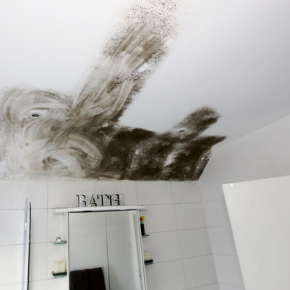
Safeguard survey discovers it’s not-so-grim Up North
A poll of tenanted households, conducted by YouGov on behalf of Safeguard Europe, the UK’s leading specialist in damp-proofing and waterproofing technology, has revealed a new North-South divide.
Renters living in the South are more likely to encounter damp and mould in their homes, compared to those living in the North.
The poll of 1,154 tenants, conducted earlier this year, found that in London, the East of England and the South East, the highest proportion of tenants reported encountering damp or mould while living in rented accommodation at 63%, 60% and 56% respectively.
Meanwhile, fewer tenants had experienced such problems in the East Midlands, the North East and Scotland at 39%, 39% and 40% respectively.

Householders were asked about problems they had come across while living in any rented property; damp and mould emerged as the number one problem, with 51% reporting to have experienced it.
Problems with drainage, water supply, poor ventilation were also prevalent with 32%, 29% and 26% reporting these issues respectively.
The survey was triggered by the introduction of a new law, the Homes (Fitness for Human Habitation) Act 2018 which came into force at the end of March this year.
The act forces private landlords to ensure their properties are fit for people to live in, giving tenants the ability to take their landlords to court if they don’t do so – something that was virtually impossible under previous existing legislation.
The poll also highlighted awareness among renters of their powers under the new legislation is relatively low, with only 35% aware of the Act.
Having been told by the researchers about the new law, 42% of those surveyed said they would be more likely to complain about problems such as damp in the light of the Act.
The question is, what could be the reason for the North-South damp divide? Weather doesn’t appear to be the main factor, as the wettest parts of the UK are Scotland, the North West, parts of the South West and Ireland, according to the Met office.
It isn’t down to the proportions of people renting either. Although more people rent in London than other regions – over half of households according to the Department for Work & Pensions – that isn’t true for the East of England and the South East.
It might be reasonable to suggest that the poorest areas suffer most from damp properties. When income is looked at, the three areas with the dampest rented properties have the highest income – and the highest income from property.
This is likely a function of affordability of rent. This is lowest in southern regions (due to high rents) meaning that renters are forced into lower quality housing
Commenting on the findings of the survey, Safeguard Europe’s MD Hudson Lambert, remarked: “It’s quite shocking to discover that in 2019, such a high proportion of households are living in homes that aren’t safe. Damp and mould aren’t just unpleasant, they lead to health problems, particularly in the young and the elderly.”
Lambert called on landlords in both the public and private sector to ensure their properties were free from damp. Damp in properties is commonly caused by rising damp, rain penetration, leaking pipes or gutters or condensation.
Although damp can be a complex issue, with the causes of damp sometimes misdiagnosed, all types of damp are treatable.
For full details of the survey, click here
Contact:
Safeguard Europe,
Redkiln Close,
Horsham,
West Sussex,
United Kingdom,
RH13 5QL
Phone: 01403 210204
Fax: 01403 217529
Visit Safeguard Europe's website
Visit Supplier's page
Latest news

19th April 2024
ASSA ABLOY: Access solutions can impact sustainability performance across the full life-cycle of a building
Embedding sustainability within any organisation requires a broad, strategic perspective. Scrutiny should include the physical infrastructure itself: According to the IEA, buildings consume around 30% of global energy*. ASSA ABLOY has more…
Posted in Access Control & Door Entry Systems, Architectural Ironmongery, Articles, Building Industry News, Building Products & Structures, Building Regulations & Accreditations, Building Services, Case Studies, Doors, Facility Management & Building Services, Information Technology, Research & Materials Testing, Retrofit & Renovation, Security and Fire Protection, Sustainability & Energy Efficiency, Video of the Week
19th April 2024
British weather doesn't dampen spirit for new HMG Garden Paint
Despite one of the wettest starts to the year on record, customers are starting to plan for brighter days with HydroPro Garden Paint from HMG Paints.
Posted in Articles, Building Industry News, Building Products & Structures, Garden, Innovations & New Products, Paints, Paints, Coatings & Finishes, Restoration & Refurbishment, Retrofit & Renovation, Site Preparation, Sustainability & Energy Efficiency, Waste Management & Recycling
18th April 2024
Abloy UK showcases new digital portfolio at The Security Event 2024
Abloy UK is set to unveil its latest line-up of access control systems at The Security Event 2024, welcoming guests to explore its cutting-edge electromechanical and digital solutions on stand 5/F50.
Posted in Access Control & Door Entry Systems, Architectural Ironmongery, Articles, Building Industry Events, Building Industry News, Building Products & Structures, Building Services, Doors, Exhibitions and Conferences, Facility Management & Building Services, Health & Safety, Information Technology, Retrofit & Renovation, Security and Fire Protection
18th April 2024
Strand is a Failsafe Choice for Emergency Exit and Panic Hardware
In times of emergency, you’re in safe hands with Strand Hardware. Although there are many considerations for building specification, few decisions can be as critical as selecting the right emergency exit/panic hardware.
Posted in Access Control & Door Entry Systems, Architectural Ironmongery, Articles, Building Industry News, Building Products & Structures, Building Services, Doors, Facility Management & Building Services, Health & Safety, Restoration & Refurbishment, Retrofit & Renovation, Security and Fire Protection
 Sign up:
Sign up: